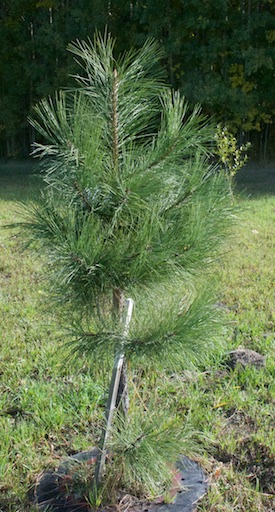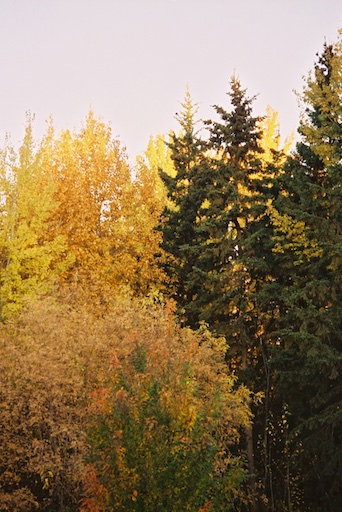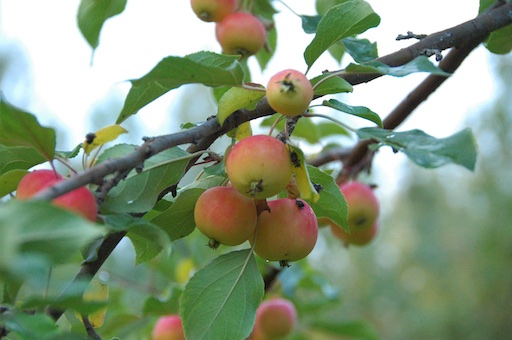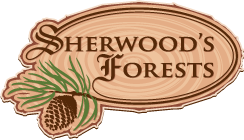
Ponderosa pine. This has the longest needles of any pine we carry.

A mix of spruce (a native conifer) and aspen poplar (a native leaf tree)

Guide to Trees & Shrubs
Sort of a catalog...
At left you will find a menu to what we have presently, or are planning to have. Everything is clumped into categories. At the start of each category is an overview, that describes general characteristics, and also the differences between the various sub groups. So for example, if you want a weeping birch tree, then read the big picture overview in Leaf Trees, then Birch & Kin, then Ornamental Birch.
There are many ways to divide trees into groups. I choose to divide them at the top by whether they have needles or have leaves. In landscaping the two classes are very different.
Conifers
Trees & shrubs with needles or scales for leaves: Pines and spruce, fir and larch, cedars and junipers.
Most people will know pine and spruce. Some will know fo firs, although many will lump them together with spruce. Many don't think of larches at all, and aren't aware that those berries on junipers and cedars are actually cones, and those green scales are leaves.
Most needle trees are narrow for their height. They produce medium to dense shade. Spruce and fir produce such dense shade that little will grow under them. Pines and larch let some sun through. Junipers don't get tall enough to matter one way or another. And cedars can be dense or loose. Some of them have ground hugging forms. Some are dwarfs. But it has needles or scales and is evergreen (except for larches) it's here.
Where they go
Generally you don't want needle trees near a window, they block the view. You want them at least 10 feet from the driveway or any sidewalk or foundation.
On the south side of the house they block the winter sun. On the north and west side of the house they block the winter wind.
Our house is on the south side of a 50 foot wide band of spruce. This gives us some protection from the winter wind. There's a 20 foot strip that melts off three weeks before everything else along this band, and I have little problem there with zone 4 plants. (We are nominally zone 3b here.)
Leaf Trees
Trees & Shrubs with, well, leaves.
Leaf trees produce shade in summer but let most of the sun through in winter. They produce medium shade -- usually lawns will grow under them without much problem. They tend to be open underneath, so that space is not lost. This means they can be planted closer to driveways and walk ways. They also tend to be wider for their height than a needle tree. And the widest part is near the top of the tree, or at least out of your way.
Leaf trees are more spread out. A conifer with a 2" trunk is a Christmas tree. A leaf tree with that size trunk will often be 15 feet tall.
Generally you can adjust the shape by pruning more easily with a leaf tree than with a needle tree.
Leaf trees produce a pile of leaves every fall. This can be a nuisance or a blessing, depending on the gardener.
I used to lump all the leafy guys into one category. Cherry was next to Cotoneaster. I'm understanding how different my reader's interests are.
So now the leaf trees are split into:
Food Forest
Trees that produce stuff you can eat.
Now, there are some trees that produce edibles, but if most people would taste, and spit, then it will be in the ornamentals instead. Also, if there are 6 edible plums, and one ornamental plum, it will be with the edibles. If there is some of each, you may find them in both. There will be notes about this in the header section of each.
Size and Inventory
Specifics on sizes are gathered in Inventory. Inventory has subsections for special interests of different types.
Here in Trees, the top section within a category e.g. 'Conifers > Pines' will have the run down on all the pines I have. Inventory is what I think I have. Frequently it's out of date. Sometimes I can get other stuff. Never hurts to ask.
Some trees are available as seedlings. Some only as larger specimens. If I can get it as a seedling, I will usually have it as somewhat larger sizes too. Some things it makes no sense to get a smaller size. E.g. A 4 foot plum would be $65 while a 6-7 foot one is $75.
Most of my trees are midsize, in 2 to 7 gallon pots. These are large enough to miss with the lawn mower, and small enough to be reasonable to plant by hand without getting on your chiropractors permanant Christmas Card list. Usually all you need to plant my trees are a shovel and a wheel barrow.
Anyway, browse the categories. I'd appreciate feedback. As usual, if I've made an error, please call it to my attention.
Got something to say? Email me: sfinfo@sherwoods-forests.com
Interesting? Share this page.
Want to talk right now? Call me: (8 am to 8 pm only, please) 1-780-848-2548
Do not arrive unannounced. Phone for an appointment. Why? See Contact & Hours That same page gives our hours of operation.
Back to Top
Copyright © 2008 - 2021 S. G. Botsford
Sherwood's Forests is located about 75 km southwest of Edmonton, Alberta. Please refer to the map on our Contact page for directions.
